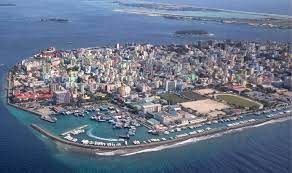The world is a busy place, with politics changing and events happening all the time. However, we make it simple to quickly read all the pertinent data for every country, in addition to flag details and an atlas summary for what kind of general information you are most interested in Maldives.
The following basic facts and information are covered in detail in each Country’s Profile:
Maps, geography, Brief history, the current ruler, area, population, capital, and largest cities – Languages-Race and ethnicity – Faith – Rate of literacy and The economy.
Facts & Information about the Maldives
LetsExplore has everything you need to know about Maldives. Check out our country profile, full of essential information about Maldives’s geography, history, government, economy, population, culture, religion, and languages.
Flag Of Maldives

Map Of Maldives

• President: Ibrahim “Ibu” Mohamed Solih served as president in 2018
Land area: 298 sq km / 115 sq mi
Population: (estimated for 2022): 390,164; growth rate: -0.14%; birth rate per 1000 people: 15.54; infant mortality per 1000 people: 25.7; life expectancy per 1000 people: 74.57
Majority and capital (2018 est.): 177,000 Malé
Currency unit: Rufiyaa (Maldivian).
The Republic of Maldives is its official name.
Languages: Arabic-derived script used for Dhivehi (official dialect of Sinhala), English (spoken by most government officials)
Race and ethnicity: a homogeneous blend of Arab, African, Dravidian, and Australasian, resulting from historical shifts in regional dominance over maritime trade routes.
Religion: Officially Sunni Muslim
July 26 is Independence Day, a national holiday.
The estimated 2016 literacy rate is 97.7%.
Economic summary:
GDP/PPP (estimated for 2020): $7.05 billion; $13,000 per person. The real rate of growth is 4.8%. 2.3% inflation was recorded. Employment: 2.9% (estimated for 2017). 10% of land is arable.
Agriculture: fish, sweet potatoes, corn, and coconuts. 222,200 workers in 2017; services accounted for 69.5%, industry for 22.8%, and agriculture for 7.7%. Tourism, fishing, shipping, boat building, coconut processing, clothing, woven mats, rope, handicrafts, coral and sand mining are among the industries. Fish are a natural resource.
Trade: $3.72 billion (estimated for 2019).Thailand (24%), the United States (13%), China (12%), France (11%), Germany (11%), Italy (5%), and the United Kingdom (5%), are the top trading partners (exports) in 2019. $4.09 billion in imports (estimated for 2019) United Arab Emirates (24%), China (16%), Singapore (14%), India (11%), Malaysia (6), and Thailand (5) are the top trading partners (imports) in 2019.
Communications: 14,508 primary lines are in use on telephones as of 2020; 717,708 mobile lines are in use. Broadcast media: 4 state-operated and 7 privately owned TV stations and 4 state-operated and 7 privately owned radio stations (2019). Until recently, state-owned radio and TV stations monopolized the market. ISPs (Internet service providers): 3,296 as of 2012. Users of the Internet: 340,542 (2020).
Transportation: 0 km of railroads. Highways: 93 km in total (2018). Malé has ports and harbors. Nine airports as of 2021.
No international disputes.
Principal references and explanations
Geography
A collection of atolls in the Indian Ocean, the Republic of Maldives is located 417 miles (671 kilometers) southwest of Sri Lanka. Its 1,190 coral islets cover 35,200 square miles (90,000 square kilometers). Since none of the Maldives’ islands rise higher than six feet above sea level, the islands are directly threatened by global warming and the retreating polar ice caps.
History
Buddhist seafarers from India and Sri Lanka first settled in the Maldives, then known as the Maldive Islands, in the fifth century B.C. Tradition has it that Islam was embraced in 1153. The islands were formerly ruled by Ceylon, which is now Sri Lanka. They were dependent on the then-colony Ceylon until 1948 when they came under British protection in 1887. On July 26, 1965, a deal on independence was signed with Britain. The islands were ruled as a sultanate for centuries until 1952 when they switched to a republican system of government. The sultanate was reinstated in 1954. However, the newly independent nation once more became a republic in 1968 as a result of a referendum. 1978 saw the removal of authoritarian president Ibrahim Nasir, who had held the position since 1968, and the election of Maumoon Abdul Gayoom, a more progressive figure. In 2003, Gayoom was chosen for a sixth five-year term.
You can also check the Country Of The World – Bahrain here!

Leave a Reply